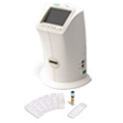| FEATURED PRODUCT | | TC20™ Automated Cell Counter |

- Accuracy and reproducibility with auto-focus technology
- Total and viable cell counts within 30 seconds
- User-defined gates for complex samples
Overview
Automated cell counting uses optical methods to count cells in fluid samples for applications such as standardizing experiments and measuring assay impact. The TC20™ automated cell counter assesses total cell count and cell viability within 30 seconds with a broad range of cell types..
Category Products
- Image
 TC20 Automated Cell Counter
TC20 Automated Cell CounterThe TC20 automated cell counter accurately counts cells in one simple step using innovative auto-focus technology and a sophisticated cell-counting algorithm. The TC20 enables accurate cell counting in less than 30 seconds.
- Image
 Cell Imaging
Cell ImagingBio-Rad's suite of tools for fluorescence microscopy and cell imaging includes the ZOE Fluorescent Cell Imager and PureBlu Nuclear Staining Dyes.








